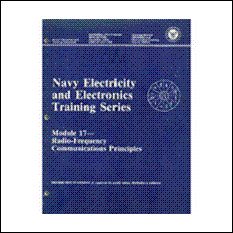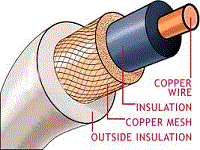Antenna Polarization
Let's review antenna polarization briefly. In (radio wave propagation) you learned that the radiation field is composed of electric and magnetic lines of force. These lines of force are always at right angles to each other. Their intensities rise and fall together, reaching their maximums 90 degrees apart.
The electric field determines the direction of antenna polarization of the wave. In a vertically polarized wave, the electric lines of force lie in a vertical direction. In a horizontally polarized wave, the electric lines of force lie in a horizontal direction. Circular polarization has the electric lines of force rotating through 360 degrees with every cycle of rf energy.
The electric field was chosen as the reference field because the intensity of the wave is usually measured in terms of the electric field intensity (volts, millivolts, or microvolts per meter). When a single-wire antenna is used to extract energy from a passing radio wave, maximum pickup will result when the antenna is oriented in the same direction as the electric field. Thus a vertical antenna is used for the efficient reception of vertically polarized waves, and a horizontal antenna is used for the reception of horizontally polarized waves. In some cases the orientation of the electric field does not remain constant.
Instead, the field rotates as the wave travels through space. Under these conditions both horizontal and vertical components of the field exist and the wave is said to have an elliptical antenna polarization.
Antenna Polarization Requirements for Various Frequencies
Ground-wave transmission is widely used at medium and low frequencies. Horizontal antenna polarization cannot be used at these frequencies because the electric lines of force are parallel to and touch the earth. Since the earth acts as a fairly good conductor at low frequencies, it would short out the horizontal electric lines of force and prevent the radio wave from traveling very far. Vertical electric lines of force, on the other hand, are bothered very little by the earth. Therefore vertical polarization is used for ground-wave transmission, allowing the radio wave to travel a considerable distance along the ground surface with minimum attenuation.
Sky-wave transmission is used at high frequencies. Either horizontal or vertical polarization can be used with sky-wave transmission because the sky wave arrives at the receiving antenna elliptically polarized. This is the result of the wave traveling obliquely through the Earth's magnetic field and striking the ionosphere. The radio wave is given a twisting motion as it strikes the ionosphere. Its orientation continues to change because of the unstable nature of the ionosphere. The relative amplitudes and phase differences between the horizontal and vertical components of the received wave also change. Therefore, the transmitting and receiving antennas can be mounted either horizontally or vertically.
Although either horizontally or vertically polarized antennas can be used for high frequencies, horizontally polarized antennas have certain advantages and are therefore preferred. One advantage is that vertically polarized interference signals, such as those produced by automobile ignition systems and electrical appliances, are minimized by horizontal polarization. Also, less absorption of radiated energy by buildings or wiring occurs when these antennas are used. Another advantage is that support structures for these antennas are of more convenient size than those for vertically polarized antennas.
For frequencies in the vhf or uhf range, either horizontal or vertical polarization is satisfactory. These radio waves travel directly from the transmitting antenna to the receiving antenna without entering the ionosphere. The original polarization produced at the transmitting antenna is maintained throughout the entire travel of the wave to the receiver. Therefore, if a horizontally polarized antenna is used for transmitting, a horizontally polarized antenna must be used for receiving. The requirements would be the same for a vertical transmitting and receiving antenna system.
For satellite communications, parallel frequencies can be used without interference by using polarized radiation. The system setup is shown in the figure below. One pair of satellite antennas is vertically polarized and another pair is horizontally polarized. Either vertically or horizontally polarized transmissions are received by the respective antenna and retransmitted in the same polarization. For example, transmissions may be made in the 3.7 to 3.74 GHz range on the vertical polarization path and in the 3.72 to 3.76 GHz range on the horizontal polarization path without adjacent frequency (co-channel) interference.

Satellite transmissions using polarized radiation.

















